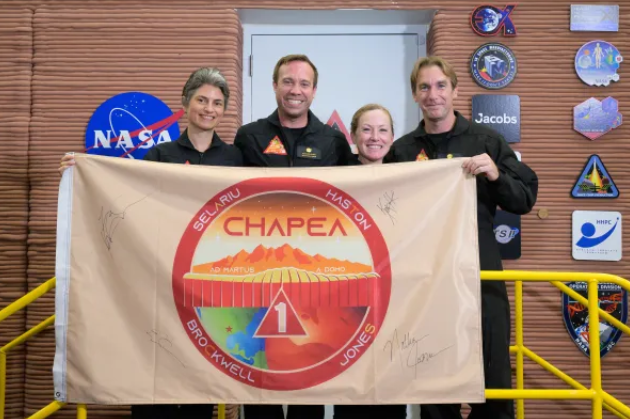
The inaugural crew of NASA's Mars Analog Mission celebrated their 100th day inside the CHAPEA (Crew Health and Performance Exploration Analog) habitat, a 1,700-square-foot facility nestled within NASA's Johnson Space Center.
This ambitious experiment commenced in June with a crew of four volunteers embarking on a remarkable 378-day Mars surface simulation.
Preparing for the Red Planet
NASA's Mars Analog Mission is a groundbreaking initiative designed to mimic the challenges and rigors that future astronauts will face during an actual Mars mission.
This includes activities such as simulated spacewalks, robotic operations, habitat maintenance, personal hygiene routines, exercise regimens, and even cultivating crops in a Mars-like environment.
One of the most intriguing aspects of this mission is the replication of Mars-realistic communication delays, with up to 22 minutes of one-way signal lag.
Despite these communication challenges, the crew has managed to periodically capture and share images, offering a fascinating glimpse into their Mars analog experience.
Life Inside Mars Dune Alpha
The habitat, affectionately known as "Mars Dune Alpha," is a testament to cutting-edge technology and thoughtful design.
It boasts four small rooms, two bathrooms, a vertical farm for cultivating salad greens, a medical care area, a relaxation zone, and several workstations where the crew conducts their mission activities.
An intriguing feature of Mars Dune Alpha is the "outdoor" area, meticulously designed to replicate Martian terrain, though it remains situated inside the hangar.
Here, the crew conducts experiments with equipment such as a weather station, a brick-making machine, and a small greenhouse, providing valuable insights into how astronauts might interact with their environment on Mars.
A 3D-Printed Habitat
Notably, the CHAPEA habitat was 3D-printed, showcasing NASA's commitment to pioneering technologies that could be employed for habitat construction on lunar and planetary surfaces.
"That is one of the technologies that NASA is looking at as a potential to build a habitat on other planetary or lunar surfaces," the lead researcher on the CHAPEA experiments explained.
As NASA continues its preparations for a mission to Mars, the CHAPEA project serves as a vital stepping stone. Currently, the agency's focus remains on the upcoming Artemis missions, which aim to return humans to the Moon for the first time in half a century.
However, the valuable insights gained from CHAPEA will undoubtedly contribute to humanity's ultimate goal: sending astronauts to Mars.
With 265 days left in their Mars analog mission, the CHAPEA crew continues to inspire us all with their dedication, resilience, and contributions to our understanding of life on the Red Planet.
Stay posted here at Tech Times.
Related Article : NASA Extends New Horizons Mission to Explore the Outer Solar System

![Apple Watch Series 10 [GPS 42mm]](https://d.techtimes.com/en/full/453899/apple-watch-series-10-gps-42mm.jpg?w=184&h=103&f=9fb3c2ea2db928c663d1d2eadbcb3e52)



